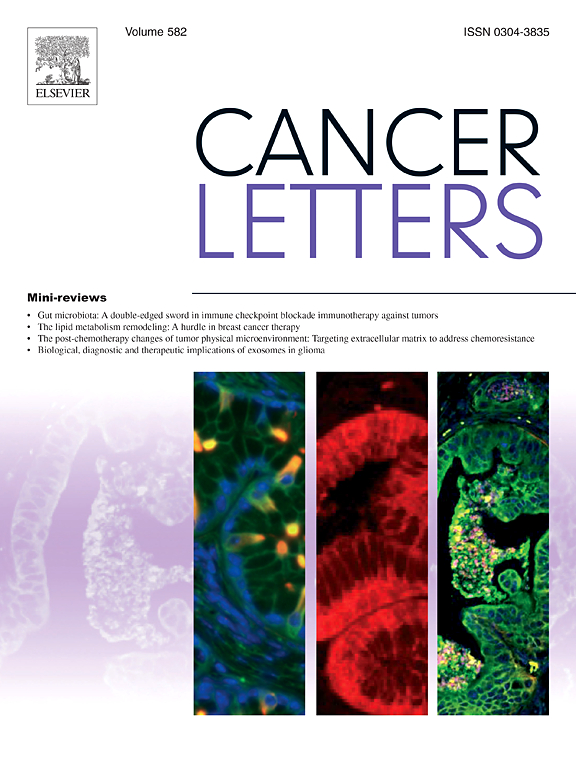整合机器学习预测的转移性乳腺癌循环肿瘤细胞 (CTC) 和循环肿瘤 DNA (ctDNA):内分泌耐药性分析原理验证研究。
IF 9.1
1区 医学
Q1 ONCOLOGY
引用次数: 0
摘要
这项研究通过利用机器学习对预测的循环肿瘤细胞(CTCs)进行预后分层,评估其与循环肿瘤DNA(ctDNA)特征的整合,并从上下文角度评估基于CTCs的转录组学的潜力,从而探索内分泌耐药性。在治疗开始前,1118 名诊断为腔隙样转移性乳腺癌(MBC)的患者通过 NGS 鉴定了 ctDNA,并通过 K 近邻算法计算了预测的 CTC。根据样本量通过秩方检验或费雪精确检验分析各亚组之间的差异,并对误诊率进行校正。生存率的差异通过对数秩检验以及单变量和多变量 Cox 回归进行检验。CTCs 经 DEPArray NxT 分选后,通过 RNAseq 进行转录组学研究。调整了ctDNA改变的单变量和多变量分析显示,CTCs预测分层对无进展生存期(PFS)和总生存期(OS)都有显著影响。RTK和ER通路的改变与预测的IV期进展期显著相关。CTCs分层和RTK/ER通路改变共同影响了患者的预后,无论突变状态如何,预测的IV期侵袭性对PFS都有负面影响。试验性探索性 CTCs 转录组学分析显示,转录变化与细胞增殖有关,如 MALAT1 表达不足,GREM1、GPR85 和 OCM 过表达。我们的数据强调了通过量化和转录组学分析整合 ctDNA 和 CTCs 的潜力,有助于深入了解 HR 阳性、HER2 阴性 MBC 的肿瘤生物学特性和治疗反应。本文章由计算机程序翻译,如有差异,请以英文原文为准。
Integrating machine learning-predicted circulating tumor cells (CTCs) and circulating tumor DNA (ctDNA) in metastatic breast cancer: A proof of principle study on endocrine resistance profiling
The study explored endocrine resistance by leveraging machine learning to establish the prognostic stratification of predicted Circulating tumor cells (CTCs), assessing its integration with circulating tumor DNA (ctDNA) features and contextually evaluate the potential of CTCs-based transcriptomics. 1118 patients with a diagnosis of luminal-like Metastatic Breast Cancer (MBC) were characterized for ctDNA through NGS before treatment start, predicted CTCs were computed through a K nearest neighbor algorithm. Differences across subgroups were analyzed through chi square or Fisher’s exact test according to sample size and corrected for False Discovery Rate. Differences in survival were tested by log-rank test and uni- and multivariable Cox regression. CTCs transcriptomics was performed through RNAseq after sorting with DEPArray NxT. Univariable and multivariable analysis adjusted for ctDNA alterations revealed a significant impact of CTCs predictive stratification on both progression-free survival (PFS) and overall survival (OS). Alterations in RTK and ER pathways were significantly correlated with predicted-Stage IVaggressive. The combined impact of CTCs stratification and RTK/ER pathway alterations influenced patient outcomes, with predicted-Stage IVaggressive having a negative impact on PFS regardless of the mutational status. The pilot exploratory CTCs transcriptomics analysis showed transcriptional changes linked to cell proliferation such as under expression of MALAT1 and overexpression of GREM1, GPR85 and OCM. Our data underline the potential of an integration between ctDNA and CTCs, both through quantification and transcriptomic analysis, for a deeper understanding of tumor biology and treatment response in HR-positive, HER2-negative MBC.
求助全文
通过发布文献求助,成功后即可免费获取论文全文。
去求助
来源期刊

Cancer letters
医学-肿瘤学
CiteScore
17.70
自引率
2.10%
发文量
427
审稿时长
15 days
期刊介绍:
Cancer Letters is a reputable international journal that serves as a platform for significant and original contributions in cancer research. The journal welcomes both full-length articles and Mini Reviews in the wide-ranging field of basic and translational oncology. Furthermore, it frequently presents Special Issues that shed light on current and topical areas in cancer research.
Cancer Letters is highly interested in various fundamental aspects that can cater to a diverse readership. These areas include the molecular genetics and cell biology of cancer, radiation biology, molecular pathology, hormones and cancer, viral oncology, metastasis, and chemoprevention. The journal actively focuses on experimental therapeutics, particularly the advancement of targeted therapies for personalized cancer medicine, such as metronomic chemotherapy.
By publishing groundbreaking research and promoting advancements in cancer treatments, Cancer Letters aims to actively contribute to the fight against cancer and the improvement of patient outcomes.
 求助内容:
求助内容: 应助结果提醒方式:
应助结果提醒方式:


